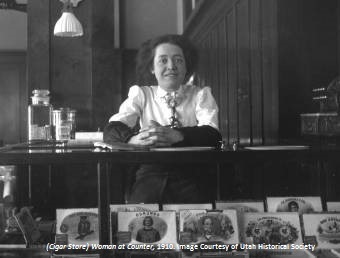Dublin Core
Title
Description
American industrialism at the turn of the 20th century brought Utah women out of their homes and into the workplace. There they faced inequality and wage disparity.
The turn of the twentieth century saw dramatic changes that created new opportunities for Utah women. Statehood marked the end of polygamy and restored women's right to vote. New laws set minimum wages and maximum working hours for Utah women. New technology brought indoor plumbing, electricity, and motorized appliances that revolutionized the household. And the growth of commercial laundries and factory-produced food and clothing relieved women of many chores and created for them jobs outside the home.
Indeed, the new American industrialism depended on women workers. In Utah factories, for example, they canned tomatoes, made soap, rolled cigars, and dipped chocolates. Many found employment staffing – and even managing – hotels and retail stores all over the state. Telephone operators were mostly women, although few advanced beyond lower supervisory positions. Women also dominated health care, as well as the teaching profession. But low teacher salaries and the failure of school boards to provide equal pay for female teachers – as was required by state law – led many women to leave classrooms for better-paying office jobs.
Some women broke into the realm of upper management. Annie Bywater, for example, managed the ZCMI clothing factory, which sold its products throughout the West. Trained in Manchester, England, Bywater was described as "a remarkably shrewd woman, with exceptional executive ability." She purchased materials, directed wholesale orders, and supervised a production line of 100 power-driven sewing machines. Whether Bywater received pay comparable to male manufacturing executives is not known, but most female factory workers did not. In 1915, for example, Utah's thirteen knitting factories employed nearly 300 workers – mostly women who earned $9 for a six-day week, while men earned $17.
As Utah grew, women fought for better working conditions, higher wages, even the right to keep their jobs after they were married. Working women filled important roles in Utah business and industry, but society would continue to underestimate – and undervalue – their contributions for many decades to come.
Creator
Source
Image: Woman at Cigar Store Counter, c. 1910. Courtesy Utah State Historical Society.
______________
See Miriam B. Murphy, "Women in the Utah Work Force from Statehood to World War II," Utah Historical Quarterly 50 (1982); Miriam B. Murphy, “A Look at Working Women in the Early 20th Century,” History Blazer, November 1995; Eileen Hallet Stone, “Utah's working women fought for their rights,” Salt Lake Tribune, August 30, 2014.

